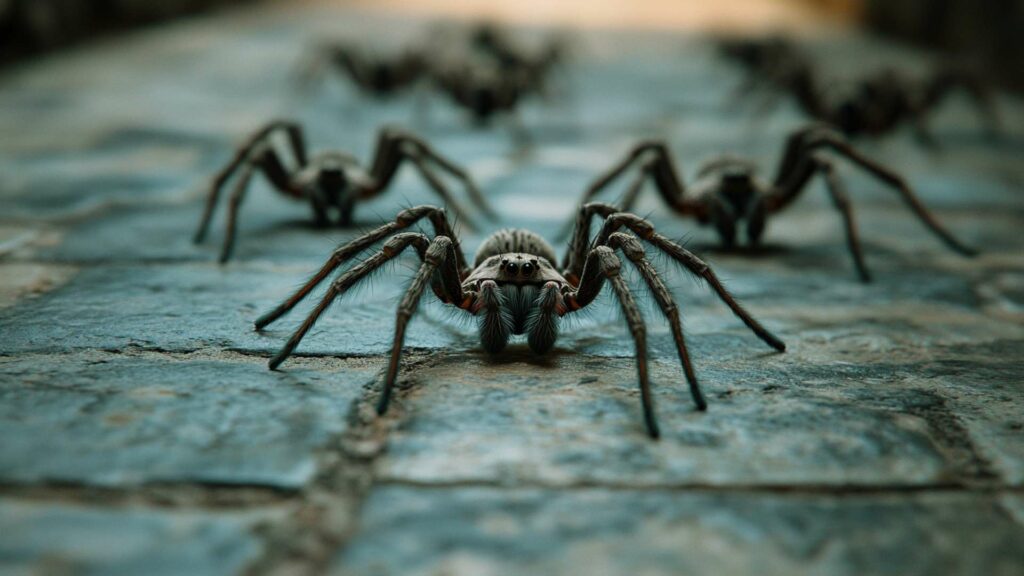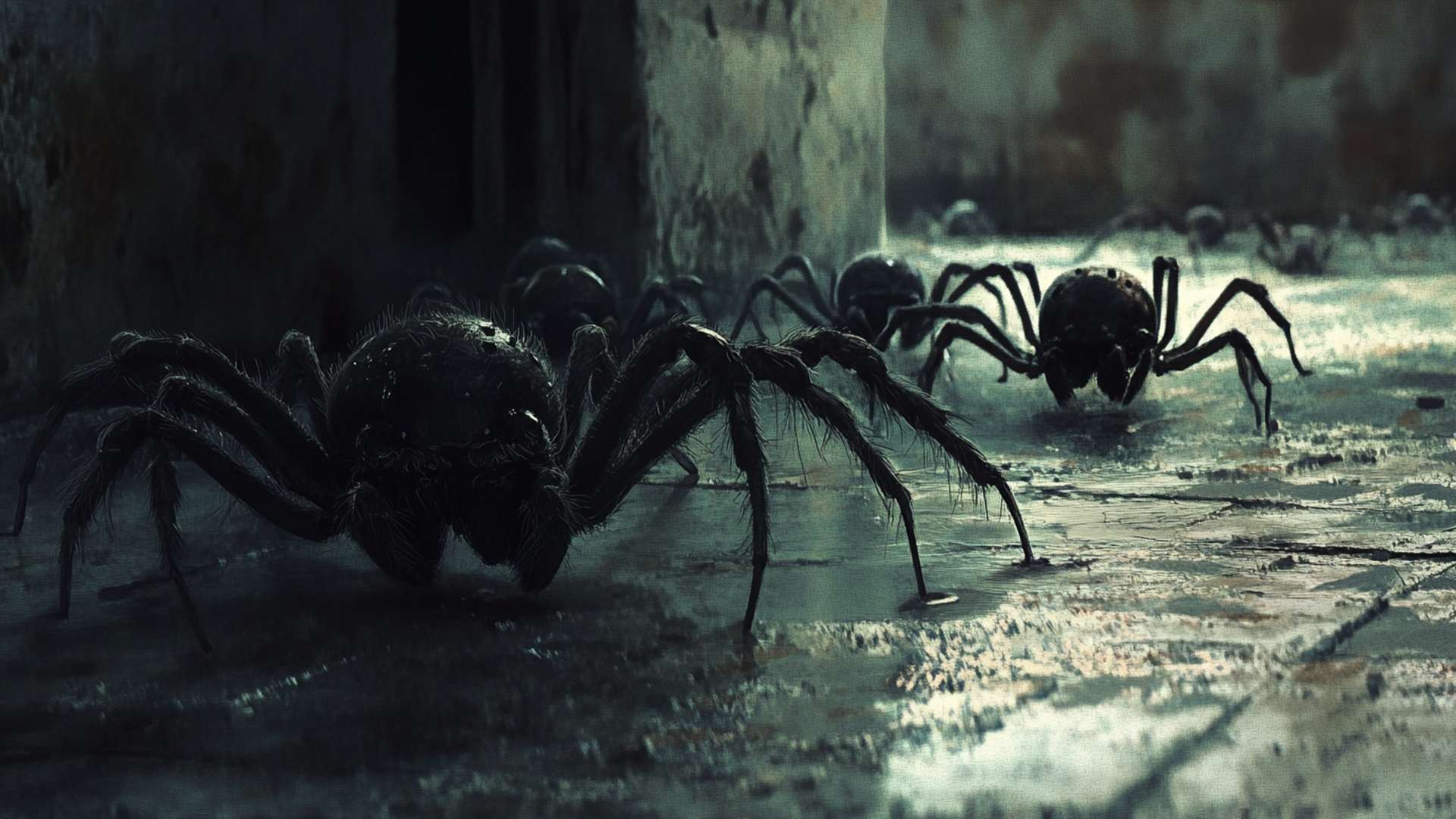The mesmerizing world of spiders, with their intricate webs and nimble movements, has long fascinated both arachnophiles and arachnophobes alike. As we delve into the subject of whether spiders are cold-blooded creatures, let us first set the stage by exploring the concept of cold-bloodedness in animals. Cold-bloodedness refers to the physiological condition where an organism’s internal body temperature remains highly influenced by external temperatures, contrasting with warm-blooded animals which can regulate their body temperature internally.
Now, turn your attention to the vast array of spiders that inhabit our planet; these fascinating arthropods belong to a diverse group comprising over 48,000 known species. From house spiders found scurrying across walls to jumping spiders displaying acrobatics on our windowsills or even elusive wolf spiders lurking in our wall and floor voids, most spider species exhibit remarkable adaptations that allow them to thrive in various environments.
Definition of Cold-Bloodedness in Animals

To understand what it means for a creature to be cold-blooded, we must grasp the fundamental distinction between ectothermic and endothermic animals. While some individuals might associate the term “cold-blooded” with cold blooded animals with an icy demeanor or lack of warmth, it actually refers to an animal’s reliance on external sources for heat regulation rather than generating heat internally like warm-blooded creatures such as mammals and birds do.
Ectothermic animals like most reptiles and insects exhibit variable body temperatures based on their environment since they do not possess internal mechanisms for temperature regulation. In contrast, endotherms maintain a relatively constant internal body temperature despite fluctuations in external conditions.
Brief Overview of Spiders as a Diverse Group
Enter the captivating world of spiders—a diverse group encompassing an astonishing variety of shapes, sizes, and behaviors. These eight-legged wonders can be found on every continent except Antarctica, showcasing their adaptability to a wide range of environments. From the infamous fiddleback spider, known for its venomous bite, to the intricate orb-weaving spiders that craft delicate webs, spiders have successfully colonized diverse habitats.
Furthermore, spider crawling skills allow them to navigate various terrains with ease. Whether they are stealthy hunters like jumping spiders or ingenious trap builders like house spiders, each species has evolved unique strategies for survival.
Anatomy and Body Structure: A World of Eight Legs
When it comes to spider physiology, these fascinating arachnids boast a unique anatomical design that sets them apart from many other creatures. With their characteristic eight legs, spiders belong to the class Arachnida, which also includes scorpions, ticks, and mites. Their bodies consist of two main parts: the cephalothorax, which houses vital organs such as the brain and digestive system, and the abdomen.
This segmented structure allows for flexibility and movement as spiders navigate their environments with agility. Within this intricate body structure lies another captivating feature: spinnerets.
These specialized appendages at the end of a spider’s abdomen produce silk threads used for various purposes such as web construction, prey capture, or shelter creation. The versatility of silk is truly remarkable – it can be elastic like a bungee cord or sticky like flypaper.
Respiration and Circulatory System: A Tangled Network Within
To sustain their activities and meet their metabolic needs, spiders require an efficient respiratory system. Unlike mammals with lungs or fish with gills, spiders have developed book lungs or tracheae to facilitate respiration.
Book lungs are thin sheets stacked like pages in a book that exchange gases between the spider’s internal tissues and the surrounding air. Tracheae are a network of branching tubes that deliver oxygen directly to cells throughout the body.
In addition to respiration, spiders possess an open circulatory system that pumps hemolymph (a fluid analogous to blood) through their bodies. Hemolymph lacks specific vessels but instead flows freely through sinuses within various organs and tissues.
As cold-blooded creatures, spiders’ physiological processes are intricately linked to external temperatures – their metabolic rate rises or falls depending on environmental conditions. Understanding these fundamental aspects of spider physiology helps shed light on their intriguing adaptations and behaviors, particularly in relation to cold-bloodedness.
Spider Metabolism

When it comes to metabolism, spiders fall into the category of ectothermic animals, just like other cold-blooded creatures. This means that their internal body temperature is primarily influenced by the ambient temperatures around them. In contrast, endothermic animals, such as mammals and birds, have the ability to regulate their body temperature internally.
While mammals can maintain a relatively constant internal temperature despite external conditions, spiders rely on external heat sources to warm themselves up. This fundamental difference in thermal regulation impacts various aspects of spiders’ lives.
Explanation of spider’s reliance on external heat sources
To stay warm and maintain optimal metabolic activity, spiders depend on external heat sources like sunlight or warm surfaces. They are often seen basking in the sun or seeking shelter in heated areas during colder days. Since they lack the ability to generate metabolic heat internally, spiders strategically position themselves in locations where they can absorb warmth from their surroundings.
For example, some house spiders may seek refuge near a home’s foundation or other areas that retain heat during winter months. In addition to using external heat sources for thermoregulation, some spider species even exhibit behavioral adaptations to make the most out of warmer days.
For instance, outdoor spider species may become more active on sunny days late summer, when temperatures rise above a certain threshold. This allows them to hunt for prey efficiently and engage in other necessary activities before colder weather returns.
Understanding how spiders rely on external heat sources is crucial not only for comprehending their cold-blooded nature but also for addressing potential issues related to spider infestations or pest control measures. By recognizing their dependence on warmth and being aware of locations where they seek warmth and solace during colder periods, homeowners can take preventive actions accordingly.
Thermoregulation in Spiders
Spiders, with their cold-blooded nature, have developed fascinating mechanisms to regulate their body temperature and ensure optimal functioning. Unlike warm-blooded animals that can maintain a constant internal temperature, spiders rely on external heat sources to warm their bodies. They are ectothermic creatures, meaning that their body temperature is determined by the surrounding environment.
During warmer days, outdoor spider species actively absorb sunlight to elevate their body temperature. This absorption occurs primarily through their exoskeletons, which act as efficient heat conductors.
By positioning themselves in sunny spots or orienting their bodies towards the sun’s rays, spiders can effectively raise their internal temperatures. In colder months or during periods of low solar radiation, spiders enter a state of torpor where they become completely inactive and conserve energy by lowering their metabolic rate.
Discussion on behavioral adaptations for thermoregulation
Spiders exhibit remarkable behavioral adaptations that aid in thermoregulation and enable them to cope with various temperatures. For instance, some house spiders construct webs strategically placed near windows or other areas where sunlight enters the room more directly. By doing so, these crafty arachnids take full advantage of the sun’s warmth while capturing insects attracted to the light within homes.
Outdoor spiders may utilize different strategies such as seeking shelter in wall and floor voids or storage areas during colder months. These hiding places offer some insulation against harsh cold weather conditions while also providing access to potential prey items seeking refuge from the elements.
In addition to these structural adaptations for thermoregulation, spiders can also adjust their posture or position themselves at specific angles relative to the sun’s rays to maximize heat absorption through different parts of their bodies. Despite being cold-blooded creatures, spiders possess impressive abilities when it comes to regulating their body temperature.
Through their unique adaptations and behaviors, they make the most of available heat sources, ensuring their survival and well-being even in challenging environmental conditions. Understanding these fascinating aspects of spider thermoregulation enhances our appreciation for these remarkable creatures and their remarkable ability to adapt to their surroundings.
The Slow Burners: Explanation of spiders’ low metabolic rate compared to warm-blooded animals
When it comes to energy consumption, spiders are like the slow burners of the animal kingdom. Unlike warm-blooded creatures that maintain a relatively stable body temperature regardless of external conditions, spiders fall into the category of cold-blooded creatures or ectotherms. This means are spiders cold blooded and that their internal body temperature is heavily influenced by the surrounding environment.
As a result, they have evolved with a significantly lower metabolic rate compared to their warm-blooded counterparts. Spiders have adapted to thrive in diverse ecosystems and climates by conserving energy through this low metabolic rate as much energy can.
By keeping their internal systems running at a slower pace, they can withstand periods of limited food supply, such as during the winter months when insect activity declines. This energy-efficient strategy allows them to survive even when resources are in poor food supply scarce.
The Scale Matters: Factors influencing metabolic rate in spiders, such as size and activity level
Just like how different spider species exhibit a wide array of shapes, sizes, and behaviors, their metabolic rates also vary significantly. Size plays a crucial role in determining the metabolic requirements of spiders.
Smaller species tend to have higher metabolic rates per gram of body weight compared to larger ones. Activity level is another critical factor affecting a spider’s metabolic rate.
Web-building spiders that remain largely sedentary invest less energy into movement than highly active hunters like wolf spiders or jumping spiders. The latter need more sustained energy for agile movements and quick hunting maneuvers.
Additionally, environmental factors such as ambient temperature also influence spider metabolism. In colder climates or during winter months when temperatures drop, many spider species enter a state of decreased activity known as diapause.
During this period, their metabolism slows down even further as they conserve energy while waiting for warmer conditions and increased prey availability. Understanding these intricacies of spider metabolic rates sheds light on their ability to adapt and survive in a world where resources fluctuate, ensuring their resilience even in the face of challenging conditions.
Cold Tolerance in Spiders

Spiders, like many cold-blooded creatures, possess remarkable adaptations that allow them to thrive in chilly climates. While most spiders are ectothermic, meaning their body temperature fluctuates with their surroundings, they have developed various strategies to endure harsh winter months. Unlike warm-blooded animals that generate heat internally, spiders rely on external heat sources to raise their body temperature and maintain metabolic activity.
Discussion on strategies used by spiders to cope with low temperatures
To combat the challenges posed by cold temperatures, spiders adopt several clever tactics. Some species seek shelter in protected areas such crawl spaces such as crevices or burrows where they can avoid direct exposure to freezing conditions. Other spiders employ natural antifreeze compounds within their bodily fluids or produce special proteins that prevent ice crystal formation and protect delicate tissues from damage.
Highlighting specific species that exhibit unique cold tolerance abilities
Several outdoor spider species have gained recognition for their exceptional cold tolerance. The common wolf spider (Lycosidae) is known for its ability to actively hunt during frosty nights when other insects are scarce. Similarly, jumping spiders (Salticidae) showcase remarkable adaptability by changing behavioral patterns during colder months and adjusting their metabolic rates accordingly.
Mentioning interesting adaptations observed in certain spider groups
One intriguing example is the brown recluse spider (Loxosceles reclusa), which possesses a unique mechanism called “supercooling.” This allows them to lower their body temperature below freezing without experiencing harmful effects from ice formation. These remarkable adaptations enable some spider species not only to survive but also thrive despite challenging environmental conditions.
Misconceptions about Spiders’ Cold-Bloodedness
There are often misconceptions about spiders being entirely at the mercy of the cold due to their cold-blooded nature. However, while they rely on external heat sources, spiders possess remarkable abilities to navigate and adapt to temperature variations in their environment actively. They display behaviors that enable them to regulate their body temperature more effectively than commonly assumed.
Debunking myths related to the topic
One common myth is that all outdoor spiders become dormant or die during winter. While it is true that some spider species reduce their activity levels during colder months due to a scarcity of food, they remain active as long as suitable conditions persist. Additionally, not all outdoor spider species are equally sensitive to cold temperatures; many have evolved mechanisms that allow them to withstand and even thrive in chilly climates.
Conclusion
While spiders are indeed cold-blooded creatures, they possess a myriad of adaptations and strategies for coping with low temperatures. Their ability to survive in cold temperatures and environments highlights the remarkable resilience and resourcefulness of these eight-legged marvels.
Understanding their unique thermoregulation mechanisms dispels common misconceptions surrounding spider behavior during winter months and sheds light on their fascinating adaptations for survival. Appreciating the complex world of spiders not only enriches our knowledge but also reminds us of the incredible diversity and ingenuity commonly found within nature’s realm.
Defeat Spiders with D-Termination: The Top Pest Control in Las Vegas!

If you’re worried about spiders invading your Las Vegas property, rest assured that D-Termination has the answer. Our expert team is dedicated to eliminating spider infestations, bringing back a sense of peace and tranquility to your space. Bid farewell to spiders—opt for D-Termination’s effective pest control today!
Contact us at 702-919-6310 or visit dtermination.com to schedule your spider control service and regain your space from these unwelcome pests.
Frequently Asked Questions:
Some spiders can die in cold weather.
Throwing spiders out the window can result in their death, but it depends on factors like height and impact.
Extremely cold temperatures, below freezing, can be fatal to many spider species.
Spiders generally prefer warmer conditions but adapt to various environments.








